Drink Driving: Legal Limit And Consequences
18 April, 2024

In Australia, the legal limit for Blood Alcohol Concentration (BAC) while driving is 0.05. If caught drink driving over this limit, the consequences can be severe. Drivers may face fines, licence suspension, and even imprisonment. It is important to remember that drinking and driving endangers not only the driver but also other road users. Hence, it is always best to have a designated driver or use alternative transportation when consuming alcohol.
Alcohol impairs cognitive functions and motor skills, leading to reckless driving. Even small amounts compromise reaction times, coordination, and judgment. Moreover, alcohol decreases attention, ability to assess situations, and decision-making. Driving Under the Influence (DUI) is a serious threat, as impaired drivers make errors and cause accidents. Therefore, adhering to alcohol limits and making responsible decisions are crucial. This article will provide more information about DUI, including the legal BAC limits and associated offences.
What is Drink Driving?
Drink driving refers to the action of using a motor vehicle while intoxicated. It involves driving over the prescribed limit for alcohol. Moreover, it is considered a criminal offence as it poses a significant risk to other road users. Therefore, individuals must adhere to the allowable blood alcohol level to prevent legal charges.
A person consuming high amounts of alcohol is prone to severe impairment. This often affects judgment, reaction time, cognitive functions, and motor skills. The more the alcohol consumption, the more severe the impairment. Thus, it diminishes the ability of a person to control a vehicle and recognise danger signs on the road.
Police officers conduct mandatory or random breath testing to monitor intoxicated drivers. This helps deter individuals from engaging in excessive consumption. During a sobriety inspection, individuals must blow to a police breathalyser to measure their BAC level. Breathalysers are non-invasive and give rapid results. If the BAC exceeds the legal limit, the driver may face corresponding penalties.
Statistics on Driving Under the Influence of Alcohol
- In Australia, a significant number of people drive under the influence of alcohol, posing a threat to road safety.
- Approximately 20% of all fatal road accidents are attributed to drink drivers.
- In 2019, there were 1,195 road fatalities due to alcohol impairment.
- On average, one person dies every two days due to alcohol-driving accidents.
- The age group most commonly involved in alcohol-related accidents is between 26 and 39 years old.
- Men are more likely than women to drive while under the influence of alcohol.
- Approximately 30,000 people in Australia have motor vehicle offences involving alcohol each year.

Drink Driving – Understanding BAC and Legal Limit
The BAC limit while driving in Australia is 0.05 for most drivers. This means that a driver is considered to be over the legal limit if their level of alcohol exceeds 0.05 grams of alcohol per 100 millilitres of blood. All drivers must understand and adhere to this limit. Otherwise, they may face penalties like licence suspension or prison term.
For individuals who hold a provisional licence or are learner drivers, the blood alcohol limit is even lower at 0.00. This means that these drivers are not allowed to have any alcohol in their system while operating a vehicle. Young or novice drivers need to understand and comply with this limit. This is because they are at a higher risk of road traffic injuries, which the effects of alcohol cause.
Aside from harsh penalties for drink driving, offenders may face an increase in insurance premiums. In addition, drivers may experience difficulty in obtaining future car insurance coverage. A high concentration of alcohol can impair judgment, reaction time, and overall driving abilities. Thus, everyone must prioritise road safety and avoid dangerous driving.
Factors Influencing BAC Levels
Various factors can affect the BAC. Firstly, the amount and rate of alcohol consumption play a significant role. Heavy drinking of alcohol or consuming it more quickly can lead to a higher BAC. Moreover, the type of alcoholic beverage can influence BAC. This is because different drinks have varying levels of alcohol.
Secondly, the body weight and composition of individuals can impact their BAC. Generally, those with a higher body weight tend to have a lower BAC compared to those with a lower body weight. The alcohol concentration reduces when the substance gets distributed in a larger volume of body water.

Consequences of Drink Driving
Police officers often use roadside breath tests to detect alcohol use on drivers. Those found guilty of drink driving offences may encounter harsh consequences. Offenders may face heavy fines, licence disqualification, and even a term of imprisonment. The charges depend on the severity of the traffic offence, such as the blood alcohol reading at the time of testing. In addition, the sanctions are based on whether it is a first-time offence or a subsequent offence.
Moreover, the court imposes an alcohol interlock program on drivers with high-risk driving offences or repeat violations. This program requires the installation of an alcohol interlock device in the vehicle. It is a type of breath-testing machine that measures the BAC. However, it will prevent the vehicle from starting if it detects alcohol in the breath sample.
Regardless of the consequences, the conviction will be recorded on the criminal history of the offender. This can adversely affect their current employment and may hinder their prospects for future employment. Seeking help from a legal advisor is recommended. Lawyers can help mitigate penalties and provide guidance in the case.
Legal Advice and Support
Offenders should seek legal advice and support. This involves finding a lawyer who specialises in handling such cases. The lawyer will guide them through the legal process, explain their rights, and represent them in court if necessary. Additionally, they will help them understand the potential consequences of the charge.
By having a legal expert on their side, the offender can better navigate the complexities of the legal system. However, the person needs to be honest and cooperative with their lawyer, providing all relevant information about the incident. This includes details about their alcohol consumption, any interactions with law enforcement, and any mitigating circumstances.
Conclusion
In conclusion, drink driving is when someone operates a vehicle while under the influence of alcohol. It impairs judgment, reaction time, and driving skills, putting everyone on the road at risk. Police use breath tests to catch intoxicated drivers, and there are blood alcohol limits in place to keep roads safe. Drivers must follow these limits to avoid legal trouble and prevent accidents. Especially for new drivers, it is essential to stay completely sober behind the wheel.
Offenders may face hefty fines, lose their licences, or even go to jail, depending on the seriousness of the offence. Additionally, they might have to install an alcohol interlock device in their vehicle. These penalties can also impact their employment and future opportunities. Seeking legal advice is crucial for navigating the legal system and minimising the impact of the charges. By working with a specialised lawyer, offenders can understand their rights, explore their options, and receive guidance.






























